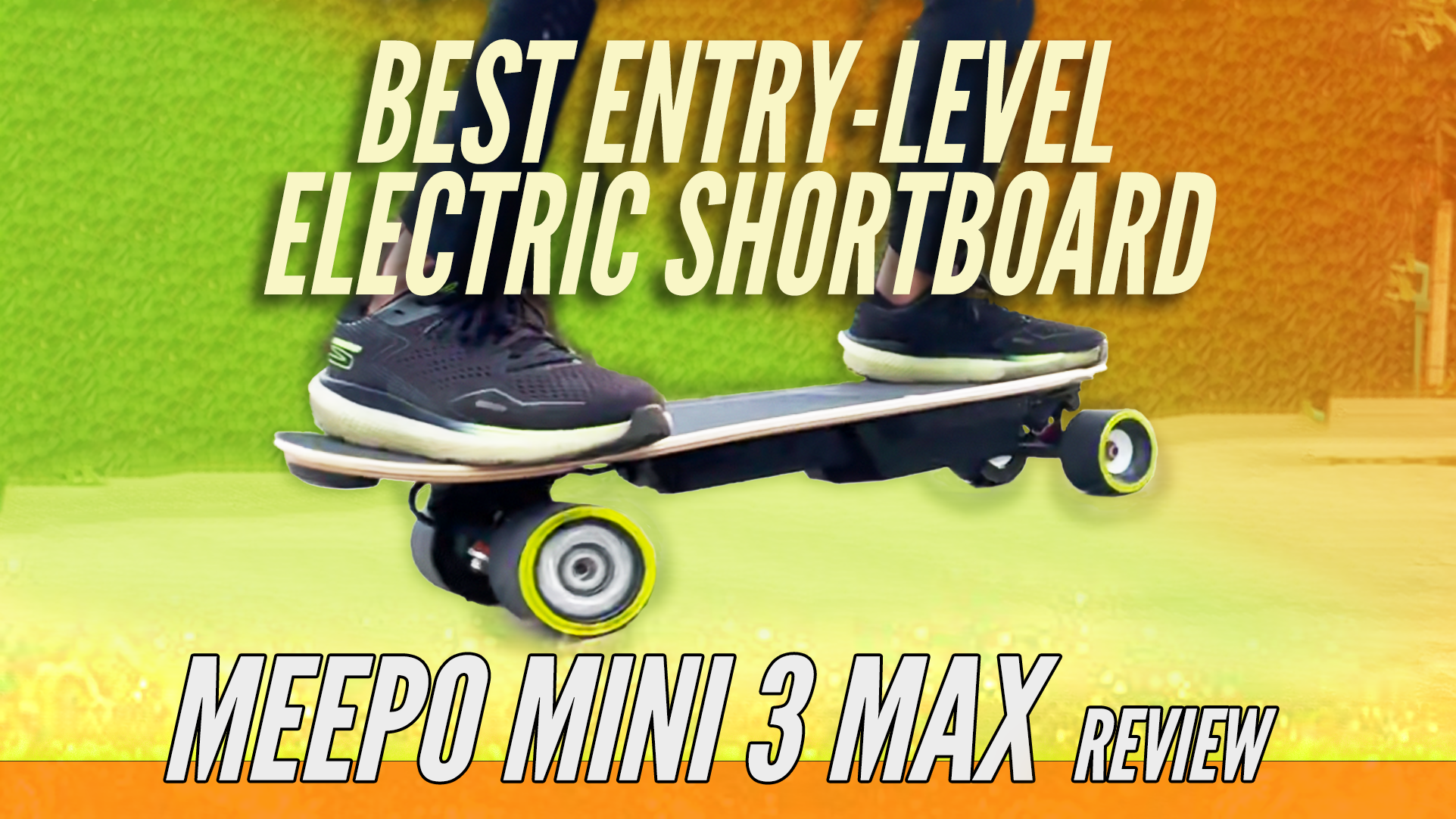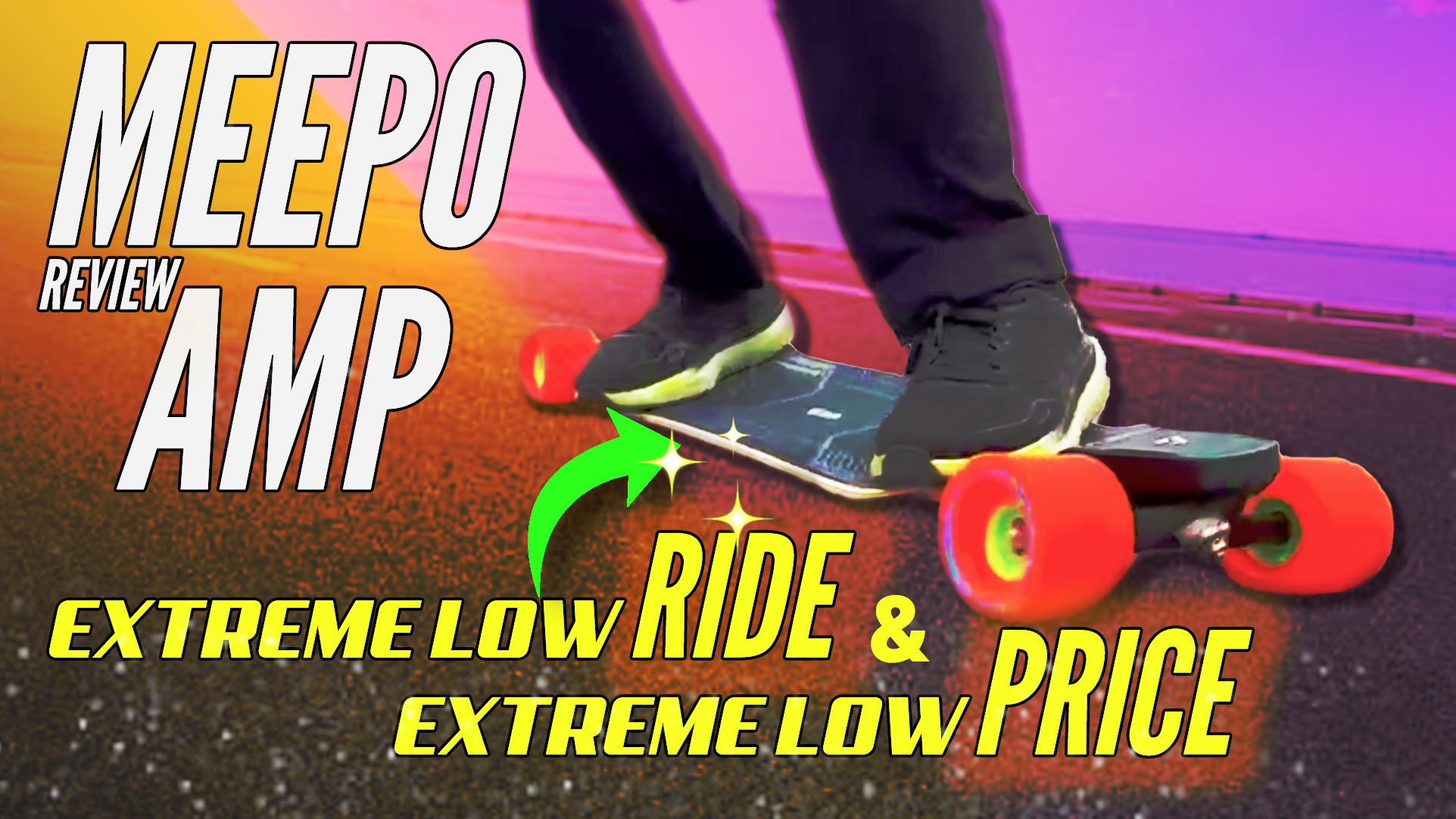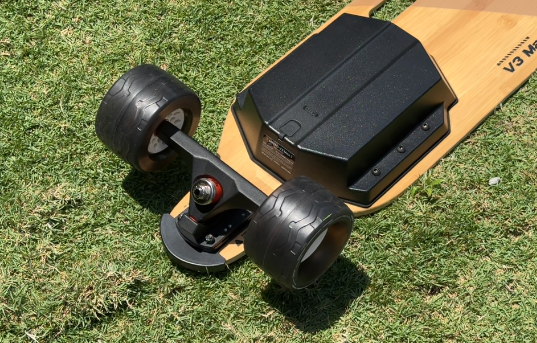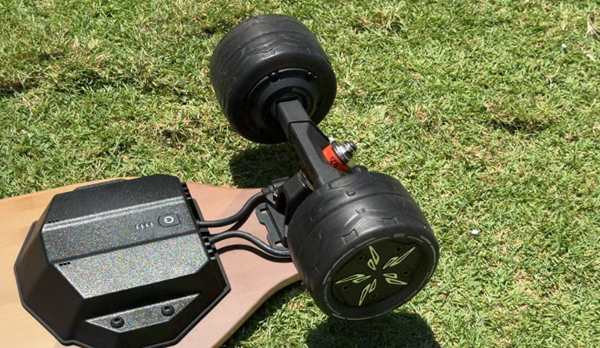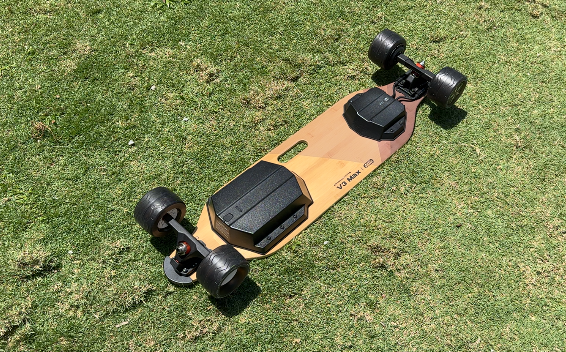The e-skate world has seen “affordable” all-terrain electric skateboards before—or at least attempts at them. But in the pursuit of cutting costs, some ended up as unpolished rides, and many lacked the power to be considered true all-terrain boards.
But now, Meepo is back with their latest concoction; the Meepo Rover—another shot at an affordable all-terrain electric skateboard. But this time, with a shockingly low price of $699.
That sounds pretty insane as nothing on the market even comes close.
But can Meepo really deliver a competent board for such a low price? Let’s break down the specs.
Meepo Rover Specs:


| Price | $699 |
| Battery | 12S4P 432 Wh 10 Ah battery |
| Controller | JK ESC |
| Top Speed | 28 mph (45 km/h) |
| Range | 20 miles (30 km) |
| Deck | 1 ply Bamboo + 10‑ply Canadian maple |
| Motor | Dual 1800 W belt-drive motors |
| Weight | 26 lbs (12 kg) |
Deck – 1 ply Bamboo + 10‑ply Canadian maple:



Starting with the deck; the Meepo Rover uses a 37.6” deck, a bit on the shorter side for an all-terrain board, which tends to be around 38-40” in length. It’s a double-drop deck made of 1-ply bamboo and 10-ply Canadian maple with a wild concave for foot placement feedback.
But here’s the catch: it’s completely stiff. With a full-length aluminum enclosure, this prevents any bit of deck flex. Normally, that would mean a rough ride—but since the Rover uses 155mm pneumatic tires, most road vibrations are still absorbed.

If this were a hub board on 90mm wheels, it would be practically unridable. These hexagon foam pads ain’t going to be enough to save your knees from all the metal vibration if this were a 90mm hub board.
Battery – 12S4P 432Wh battery:


Next, housed in the aluminum enclosure is the JK ESC and a 12S4P 432Wh battery. We previously made this chart while researching the best affordable AT boards, and most boards around $899 and up come with ~550Wh batteries. So at $699, this is a fair compromise.
The Rover boasts a modest range of 20 miles (30km) per charge—not a long-distance champ, but about enough for most riders.
Electronic Speed Controller – JK ESC


The JK ESC is fairly new, developed by the former chief engineer at Hobbywing, which first tried it on the 2024 Meepo Edge and Meepo Go. Just like Hobbywing, it offers 4-speed modes and a smart power-on feature: turn on the remote, and the board powers up automatically.
To our knowledge, this is the first time JK ESC is used in an all-terrain board —and it performs well. Acceleration and braking are smooth but punchy. The first two modes are beginner-friendly, while S and S+ modes deliver serious fun.
The Rover comes with the J6S remote instead of the color remote found on the V3 Max series- and unfortunately, it doesn’t support advanced customization unlike the LingYi ESC + M6C Remote combos.
Motors And Wheels – Dual 1800w Belt-Drive Motors, Paired With 155mm Pneumatic Tires:


Also, the Rover runs on dual 1800W belt-drive motors, paired with 155mm pneumatic tires. Now, wattage alone doesn’t tell the full story. Take a look at these $900–$1200 AT boards—some have 1500W motors, others 2100W or even 3500W.
| Brand | Category | Model | Price | Battery Size (Wh) | Top Speed (kmh) | Weight | Battery Spec | Range (miles) | Range (km) | Top Speed (mph) | Drive Train | Motor |
|---|---|---|---|---|---|---|---|---|---|---|---|---|
| Propel | 2 in 1 Longboard | Propel Pivot S | $899.00 | 518Wh | 60 Kmh | 25.4 lbs / 11.5kg | 12s3p | 16 miles | 25 Km | 37 mph | Belt | 2x 6374 |
| Ecomobl | AT Longboard | Ecomobl ET Pro | $899.00 | 648Wh | 55 Kmh | 27 lbs / 12.2kg | 12s3p | 28 miles | 45 km | 35 mph | Gear | 2*3500W |
| Meepo | AT Longboard | Meepo Hurricane Bamboo | $899.00 | 544Wh | 48 Kmh | 30.4 lbs / 13.8kg | 12s3p | 21 miles | 35 Km | 29 mph | Belt | 2*3500W |
| Wowgo | AT Longboard | WowGo AT2 Plus | $899.00 | 604Wh | 50 Kmh | 30 lbs / 13.6 kg | 12s4p | 27 miles | 43 km | 31 mph | Belt | 2*2100W |
| Verreal | 2 in 1 Longboard | Verreal RS AT | $949.00 | 720Wh | 43 Kmh | 10s4p | 31 miles | 50 km | 27 mph | Belt | 2*1500W | |
| Propel | Suspension board | Propel Endeavor3 S | $999.00 | 691Wh | 55 Kmh | 46 lbs / 21kg | 12s4p | 30 miles | 48 Km | 34 mph | Belt | 2x 6374 |
| Propel | 2 in 1 Longboard | Propel Pivot GT | $999.00 | 864Wh | 60 Kmh | 31.97 lbs / 14.5kg | 12s4p | 33 miles | 53 Km | 37 mph | Belt | 2*3000W |
| OMW | AT Longboard | OMW Hussar | $999.00 | 648Wh | 55 Kmh | 33 lbs / 15kg | 12s3p | 28 miles | 45 Km | 34 mph | Belt | 2*3500W |
| Tynee | AT Longboard | Tynee Explorer | $999.00 | 726Wh | 60 Kmh | 30 lbs / 13.8 kg | 12s4p | 44 miles | 71 km | 37 mph | Belt | 2*3500W |
| Maxfind | AT Longboard | Maxfind FF AT | $1,099.00 | 376Wh | 45 Kmh | 28 lbs / 12.7kg | 12s3p | 17 miles | 28 Km | 28 mph | Hub | 2*1500W |
| Backfire | AT Longboard | Backfire Ranger X5 | $1,099.00 | 518Wh | 42 Kmh | 28 lbs / 12.8kg | 12s3p | 21 miles | 35 Km | 26 mph | Hub | 2*1500W |
| Exway | 2 in 1 Longboard | Exway Atlas | $1,149.00 | 518Wh | 50 Kmh | 25.4 lbs /11.5kg | 12s3p | 19 miles | 30 Km | 31 mph | Belt | 2*1500W |
| Evolve | 2 in 1 Longboard | Evolve Bamboo GTR AT | $1,199.00 | 504Wh | 44 Kmh | 24.5 lbs / 11.1kg | 10s4p | 31 miles | 50 Km | 27 mph | Belt | 2*3000W |
| Tynee | AT Longboard | Tynee Explorer Pro (Hub) | $1,299.00 | 1008Wh | 50 Kmh | 35 lbs / 16kg | 14s4p | 50 miles | 80 km | 34 mph | Hub | 2*2500W |
| ACEDECK | AT Longboard | Acedeck Nomad N1 | $1,399.00 | 652Wh | 60 Kmh | 33.1 lbs / 15kg | 14s3p | 25 miles | 40 Km | 37 mph | Belt | 2*3500W |
| Meepo | AT Longboard | Meepo Hurricane Bamboo Pro | $1,399.00 | 726Wh | 51 Kmh | 35.5 lbs / 16.1kg | 12s4p | 31 miles | 50 Km | 32 mph | Belt | 2*3500W |
| ACEDECK | AT Longboard | Acedeck Nyx Z3 | $1,599.00 | 777Wh | 60 Kmh | 41.6 lbs / 18.9kg | 14s3p | 25 miles | 40 Km | 37 mph | Gear | 2*4500W |
| ACEDECK | AT Longboard | Acedeck Horizon | $1,999.00 | 1036Wh | 60 Kmh | 42 lbs / 19.05kg | 14s4p | 37.5 miles | 60 km | 38 mph | Gear | 2*4500W |
The Rover tops out at 28 mph (45 km/h), which is average by today’s standards. But torque is what really matters for all-terrain riding. And thankfully, the Rover is not too shabby at torque.
The board uses a 15:55 gear ratio—a 3.67 reduction. Not the crazy 4:1 or 5:1 ratios seen in ultra-torquey setups, but still pretty balanced. And thanks to its smaller 155mm wheels, it manages to squeeze more torque out of the motors.
The result? A board with strong low-end power. Acceleration is punchy, and getting up to top speed feels quick and exciting. It’s actually kind of thrilling, which is to no surprise that Meepo stamped “Hurricane” on the bottom of the deck.

That being said, let’s be real—it’s not as strong as a full-blown high-end AT board. Meepo probably held off on giving it the full Hurricane name for that reason. Still, performance is easily on par with most $899–$1000 AT boards, and just a couple of steps behind the $1200+ tier. It’ll climb hills, power through sandy paths, and cruise over short grass with no issue. Where it might struggle is doing all that at once—uphill plus off-road, and that’s where it shows its limits.
Trucks – Traditional Kingpin trucks:


The Rover comes with Traditional Kingpin trucks, which is an interesting choice over the usual double kingpin setup for AT builds. Traditional Kingpin trucks strike a balance between Dual Kingpin’s maneuverability and Reverse Kingpin Trucks’ stability. And for high-speed boards—or shorter decks like the Rover—it’s a smart move.
At 37.6″, the deck doesn’t really need the ultra-tight turning of Dual Kingpin trucks. The Traditional Kingpin truck setup already feels very similar in carving, with added stability. And honestly, that’s all you need. The Rover isn’t very high off the ground, as it runs on 155mm wheels, and caps at 28 mph, so stability isn’t a huge challenge here.
Specs Summary of the Meepo Rover:



Besides the stiff, flexless enclosure, there’s not much to complain about. On paper, this board gives you everything we expect from an $899 AT board—but for just $699.
Another thing worth highlighting is that the Rover weighs just 26 lbs (12 kg). That’s about 10 lbs (4.5 kg) lighter than something like the Hurricane Bamboo Pro. If you need to carry your board during a commute, that weight difference is going to matter.
Riding Experience of the Meepo Rover:


It’s pretty obvious that the Meepo Rover succeeds where the City Rider failed—delivering the power people expect from an all-terrain board. Meepo labeled its previous budget AT boards as “City Riders” for a reason, as they lacked the clearance and torque needed for actual off-road use.
The Meepo Rover, on the other hand, doesn’t have those limitations. Not only can it handle off-road paths, but it’s also quite comfortable to ride. The 155mm pneumatic wheels absorb most of the vibration, making for a smooth experience.
The Rover has noticeably more torque than its predecessors and is tuned for a punchier acceleration profile. It’s a fun ride. The lower price didn’t result in lower power, just a shorter range. Movement control is smooth, carving is enjoyable… I mean, what else is there to say? What more could you ask for? (besides maybe a little flex in the deck)
Verdict of the Meepo Rover:


This review of the Meepo Rover basically wraps up our coverage of Meepo’s 2025 lineup. And it looks like Meepo is going all-in on a price war this year. All four of their boards (This, Meepo V3 Max – longboard, Meepo Mini 3 Max – shortboard, Meepo Ampboard – singlehub) undercut the competition significantly in price, yet still deliver solid specs and enjoyable ride experiences.
At $699, the Meepo Rover is not only the most affordable all-terrain electric skateboard on the market right now—it’s also the first truly capable one we’ve ever reviewed at this price point. And until the competition catches up, the Meepo Rover will be our new default recommendation for anyone looking for an entry-level all-terrain electric skateboard.
If you are interested in buying the Meepo, be sure to check out our affiliate discount link here and use code: “ESKATEHQ” to receive $15 off during checkout.
It will help you get a small monetary discount and help us out too. On top of that, you’ll be tagged as an Electric Skateboard HQ customer and probably be treated better. Cheers!





